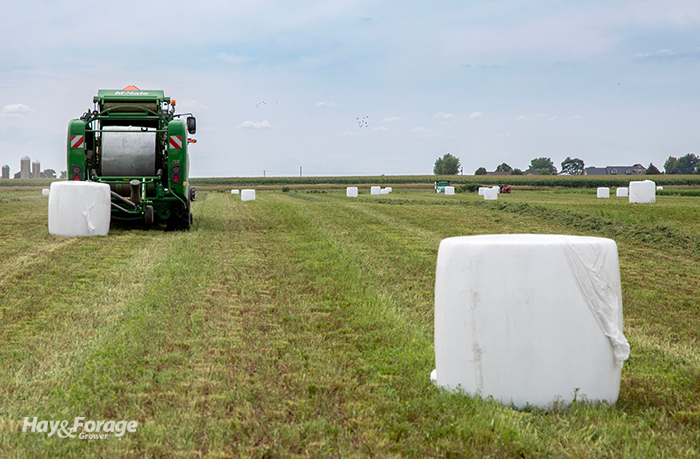
In the world of haymakers, the dry hay balers and higher moisture choppers comprise most of the electorate. Somewhere in between are the baleage makers, but their numbers among the voting public are growing.
Recently, I was asked to review a lengthy paper that summarized the current state of baleage research and recommendations. It reminded me of how much more we know about strategies for successful baleage production today compared to 20 years ago.
These days, the options for making good baleage are numerous and include individual bale wrapping, on-the-go bale wrapping, and in-line bale wrapping. You can also have your choice of round or large square bales.
The surge in baleage production throughout the humid regions of the U.S. is relatively easy to explain. Though there are additional expenses involved, they are much less than a traditional chopped haylage system. Those farm units that are already set up to make and feed large round or square bales can easily convert to baleage. The ability to harvest and preserve high-moisture hay shortens the needed wilting time, a real advantage where rain and humidity characterize the environment.
Compared to dry hay baling, the shortened drying time and reduced harvest losses attributed to baleage are what offer farmers a measurable economic advantage. On some beef farms, high-quality baleage often takes the place of supplement feeding. A few years ago, I was interviewing one prominent beef seedstock producer who volunteered this statement: “Baleage is a game changer for the beef industry.”
Another beef producer that I visited with told me they didn’t start making baleage because of reduced wilting time compared to dry hay; they adopted a baleage system to beat the drought years. Baleage offered them a system to make additional high-quality feed early in the spring from fall-planted winter annuals. If summer pastures shut down, they have prepackaged pasture to fall back on.
Perhaps a key advantage of baleage — one that is not initially considered — is less wastage during feedout. After incorporating baleage into a feeding program, this is often one of the first observations made, and the difference in waste can be upward of a 15% advantage for the high-moisture forage.
Iowa State University extension specialists estimated a cost savings of 33 cents per head per day for a cow-calf winter diet with baleage versus dry hay fed in a ring feeder. The advantage comes from improved forage quality, a lower supplement cost, and reduced wastage.
Of course, baleage making is not limited to beef production. Dairy producers and many custom harvesters have also jumped on the baleage bandwagon. Grass-fed milk dairies often use baleage as their primary winter feed when pastures are dormant.
The road to success
With a great deal of producer experience and a strong research effort in recent years, the recipe for making top-notch baleage is now clearer. Virtually any hay-type crop can be harvested and wrapped successfully, although some are easier than others, depending on their ability to go through a rapid and complete fermentation.
The list of practices from producer experience and previous research that will lead to successful baleage production include:
1. Have the right equipment. Everything, including the baling tractor, the baler, and all bale-moving equipment, must be stouter and more powerful to handle the heavier bales.
2. Don’t cut more hay down than you can timely wrap after baling. This is a system where one operation will impact the next.
3. Target a baling moisture range of 50% to 60% for optimum fermentation. In some cases, plus or minus 5 percentage units out of this range can also result in an acceptable product. Wetter baleage will go through a more optimum fermentation, but if it is too wet, the risk of butyric acid production rises.
4. Make dense bales; they wrap and preserve better. This may require a slower baling ground speed and a higher power take-off (PTO) speed. Research has shown that dense bales (at least 8 to 10 pounds per cubic foot) have a lower pH and offer an extended bunk life.
5. Wrap bales as soon as possible after baling. Most research shows that a reasonable target is to have everything wrapped within 12 hours of baling, but sooner is always better. If forage is allowed to heat before being wrapped, the buffering capacity of the feed rises, and it becomes more difficult to get a good fermentation.
6. Select a suitable site for storage, ideally on a graded, rock surface. Ensure that bales don’t impede natural water flow. Store bales where plastic integrity can be maintained, keeping them away from trees where branches may fall. Control weed growth in the storage area but don't place bales on freshly mowed areas where coarse stubble can puncture the plastic wrap. Stored bales need to be routinely checked for damage from wildlife and rodent activity. Repair any holes in the plastic immediately.
7. Ensure that bales are uniform in size. This is especially important when using an in-line wrapper. Push bales together tightly, which prevents air pockets from forming.
8. Store and inventory baleage based on forage quality. Many producers use spray paint to mark the outside of individual bales or line wraps with field information. Target the highest quality feed to those livestock classes that are growing or lactating.
9. Feed baleage within nine months of harvest. Forage quality begins to deteriorate after that point. It is also desirable to let bales ferment at least eight weeks before they are fed. Finally, use a feeding system that won’t promote waste.